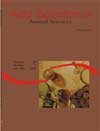<b>Efeito de métodos e intensidades de pastejo sobre a ressemeadura natural de azevém anual</b> - DOI: 10.4025/actascianimsci.v30i4.6463
Resumo
Este trabalho foi conduzido na E.E.A da UFRGS/RS (30°05’S e 51°39’W) com o objetivo de avaliar o efeito de métodos e intensidades de pastejo na dinâmica populacional de azevém (Lolium multiflorum Lam.) em ressemeadura natural. Conduziu-se a pastagem em dois métodos de pastejo (lotação contínua e rotacionada) e duas intensidades de pastejo (moderada e baixa), em um delineamento em blocos casualizados, em esquema fatorial com três repetições (2x2x3). No ano seguinte, após um ciclo de lavoura de soja no verão, foi contado o número de perfilhos de azevém estabelecidos via ressemeadura natural. Os resultados demonstraram não ter havido interação (p > 0,05) entre os métodos e as intensidades de pastejo, e seus efeitos foram analisados de forma independente. Enquanto os diferentes métodos de pastejo não afetaram a ressemeadura do azevém (p = 0,4636), as diferentes intensidades de pastejo a influenciaram significativamente (p = 0,0003). O número de perfilhos de azevém estabelecidos via ressemeadura natural, na intensidade de pastejo baixa, foi maior (6.776 perfilhos m-2) do que na intensidade de pastejo moderada (211 perfilhos m-2). O controle da intensidade de pastejo é um fator determinante para a manutenção do azevém em sistemas de produção baseados na persistência dessa forrageira via ressemeadura natural.Downloads
DECLARAÇÃO DE ORIGINALIDADE E DIREITOS AUTORAIS
Declaro que o presente artigo é original, não tendo sido submetido à publicação em qualquer outro periódico nacional ou internacional, quer seja em parte ou em sua totalidade.
Os direitos autorais pertencem exclusivamente aos autores. Os direitos de licenciamento utilizados pelo periódico é a licença Creative Commons Attribution 4.0 (CC BY 4.0): são permitidos o compartilhamento (cópia e distribuição do material em qualqer meio ou formato) e adaptação (remix, transformação e criação de material a partir do conteúdo assim licenciado para quaisquer fins, inclusive comerciais.
Recomenda-se a leitura desse link para maiores informações sobre o tema: fornecimento de créditos e referências de forma correta, entre outros detalhes cruciais para uso adequado do material licenciado.








































